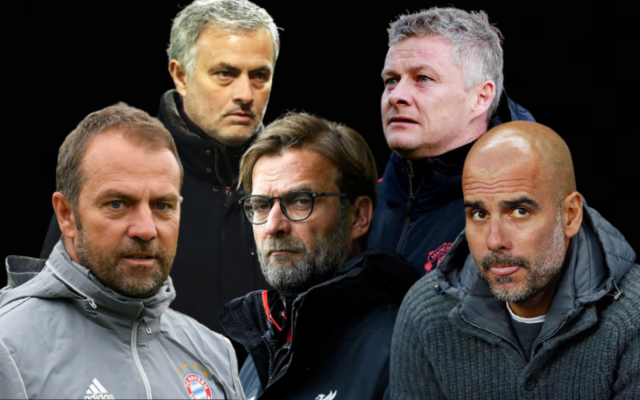Have you ever been left completely befuddled with the technical terms coaches use in their post-match conferences? FootTheBall ‘Explainer’ keep unravelling and simplifying the technical jargon used by top coaches in interviews. One such term that causes a lot of confusion is ‘Transitions’.
Not to be confused with counter-attacking, it is a different concept altogether. In fact, counter-attacking is only a small part of these ‘Transitions’ as a concept.
2. Field of view
“It is important that you go beyond the field of view of the opponent. When you run in front of him, he sees you and can also start sprinting, or take care of you with physical contact. If you run out of his sight, he has lost you…. pic.twitter.com/4qGohQnVKm— The Tactics Board (@tacticsboardtw) April 30, 2020
What are Transitions in football?
A transition in football is defined as the process of recognizing and responding in the first few seconds after losing or regaining possession of the ball. Experts define transitions as a process which involves pressing and counter-pressing in midfield. The purpose is to win the ball relatively close to the opposing goal, then use the disorganization of the other team to catch them off-guard.
A team’s general tactics imply a constant interaction between attack and defence patterns. The complex nature of these interactions guides the passage of play from one area of the pitch to another, so it requires time for adaptation, which includes varied responses in the case of defending after attacking (defensive transition), or attacking after defending (offensive transition).
Often spaces are left vacant when the ball changes possession in a split second, it is said the player closest to the change in possession has the highest chance of influencing the game in the next few seconds.
From a defensive viewpoint, it involves cutting passing lanes, pressing and reorganizing the shape of the defence covering and making it hard for the attacking teams to exploit the gaps left by players, not in a defensive position.
An offensive transition is something that is more noticeable in a game as it often leads to goals or high-quality chances that are usually created at an incredible pace. So in the offensive sense, a transition simply means the team’s ability to exploit spaces and establish a numerical advantage in dangerous areas of the pitch against a disorganized defence.
Thus, modern-day coaches look to develop the speed at which they can get their players to act or react immediately after they have regained or lost possession, helping them understand how they can take advantage of such situations.
How relevant are transitions
Transitions have become the most crucial part of football tactics in today’s time and date. Every team in world football currently, coherently or incoherently has developed patterns of play that can be defined as transitions. Every manager from the likes of Klopp to an Allardyce, make use of these transitions to attack and defend.
Jens Bangsbo, former Juventus sports scientist, and Birger Pietersen, former Danish women’s team coach, in their chapter on tactics and strategies in the new book, Soccer Science, mention the importance of transition and can be quoted saying, “Over the last few years, transitions have become a crucial tactical concept in the game plan of many teams. Teams are focusing on taking advantage of situations when they regain the ball, because the opposition’s defence is often disorganized at that moment”
In a game between Crystal Palace and Liverpool, Firmino’s first goal was a perfectly executed offensive transition. Liverpool broke after dealing with a Crystal Palace corner, Firmino released Robertson on the wing around the halfway line, received the ball back in space right at the edge of the box, and calmly slotted the ball past Guaita for Liverpool’s third goal.
🎞 𝑺𝒉𝒐𝒘𝒓𝒆𝒆𝒍 🎞
🎶 There's something that the Kop wants you to know…🎶
Enjoy Bobby's brilliance against Palace 🤩 pic.twitter.com/hcvbbchD87
— Liverpool FC (@LFC) December 21, 2020
How important are transitions for managers?
The likes of Klopp, Guardiola, and Flick look to dominate possession through these transitions. As they tend to take the game away from their opposition. They do this by making sure their team is always trying to regain the ball in the defensive third of the opposition using these transitions as a number 10. As a result, giving rise to the high-intensity style of press followed by their teams. Mourinho and Conte, use the principles of transition to set up their teams differently.
Their teams are set up for swift counterattacks, as they set traps in midfield and their own defensive third, allowing opposition teams to have the ball and dominate possession, only to invite the other team further up the pitch leaving space in behind the opposition defence.
Often in games, it forces teams that have regained the ball to go and attack, and when these traps come into play, they look to break at pace and attack the disorganized defence. An Allardyce or a Steve Bruce, on the other hand, do not use transitions for attacking as much as the above mentioned lot. Their teams, however, do heavily rely on defensive transitions, to make sure they don’t concede ‘silly’ goals. They do this by making sure their set of players always maintain their shape, even when they lose the ball. This makes it extremely hard for the opposition team to break the stubborn and organized defences down.
With more and more new principles being added and invented in the world of football by young and experienced managers, football has become a highly unpredictable game more so than ever. And the concept of transitions plays a major role in modern football.




